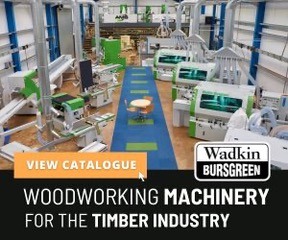Cabinet Vision and Alphacam software plays a big part in helping woodwork graduates from a college in Ireland find jobs all over the world.
The Letterfrack campus of the Galway-Mayo Institute of Technology (GMIT) is a National Centre of Excellence providing honours degrees in furniture design, wood technology and teacher training.
Known as The Furniture College, GMIT Letterfrack, in County Galway, celebrated its 25th anniversary at the end of 2012 with a major exhibition of students’ work at the prestigious Farmleigh Gallery, at Dublin’s Phoenix Park.
Head of department, Dermot O’Donovan, says the institute has developed from a small campus of just 18, to the current 250 full-time students taking a range of degree courses, as well as the additional Higher Diploma for those wanting to go into teaching.
As well as GMIT’s partnership with Cabinet Vision and Alphacam, the college has also a close working relationship with machinery manufacturer, Homag, which updates the college’s complete Weeke cell every two years.
“Our strength is in showing students what’s possible within the industry, integrating the core values of craft and quality with technology,” says Dermot.
“We show them that the manufacturing process has to be technologically driven for it to have a sustainable future.”
He goes on to say the combination of GMIT’s Homag and Rye machines with 36 Alphacam seats, and 33 seats of Cabinet Vision Ultimate – including Screen to Machine – has aided the college in gaining global recognition.
Design and CAD/CAM lecturer Jeremy Madden says all second year students are introduced to Alphacam to drive the Homag cell – which comprises a beam saw, edgebander, two CNC routers and laser – to create a simple cabinet.
The college began teaching Alphacam programming when it aquired its first CNC machine in 1996. Its use was developed by IT technician Gary Graham, who says that whenever they bring a product into GMIT’s syllabus it has to be mainstream – and be the best that’s available – and Alphacam fitted that bill perfectly.
When Jeremy Madden joined the college four years later, he had extensive experience of working with Alphacam within the industry, and says the demand was increasing to make technology a core element of the syllabus.
As well as incorporating CAD/CAM into the Advanced Machine Technology module and Graphics Computer Applications for second year students, more advanced aspects are taught in later years, ensuring there’s a complete link with Alphacam right the way through a student’s time at Letterfrack.
When GMIT begin using CAD/CAM in its second year, students are working on prototype and conceptual pieces constructed from simple formers, as well as developing ideas and complexity of shapes.
Jeremy Madden says the designs come from a batch project including items such as pen boxes and other stylised small items. The third year sees an introduction to 3D solid modelling as part of a compact one semester brief taking the development of complex shapes to a higher level.
“Alphacam gives a whole new dimension as to what can be created, visualised, drawn up and machined,” he says.
Those skills are combined in the fourth year, where they are also shown how Cabinet Vision does much more than cut, lip and bore panels, and focus is switched to the ease with which it produces cabinets through advanced solid modelling technology, automatically generating shop drawings, 3D renderings, cut lists, material requirements and estimating.
The cabinets are designed in Cabinet Vision and the NC codes generated in Screen to Machine. Although cabinets can be designed at the touch of a button, Gary Graham from GMIT says the fact that Cabinet Vision also allows students to create their own construction styles for one-offs and non-standard pieces is important.
“We didn’t want them just to select stock from Cabinet Vision’s library, as we felt that was limiting to their education,” he says.








